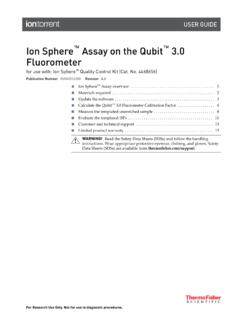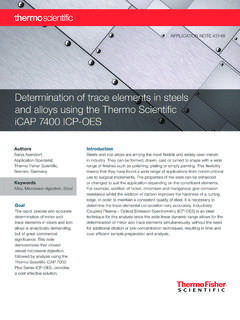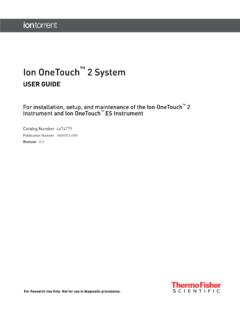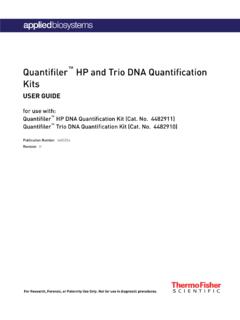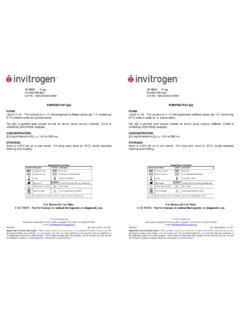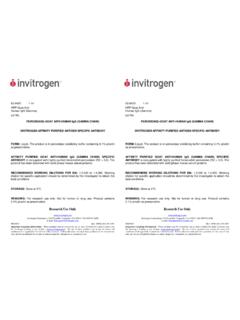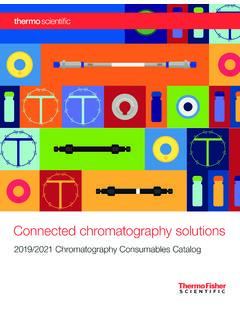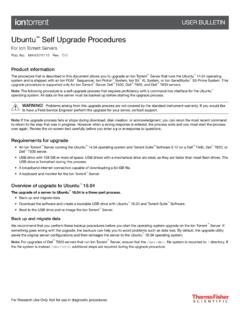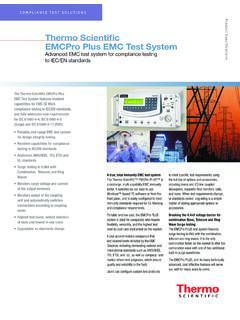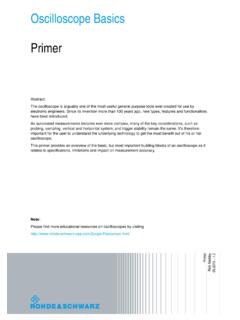Transcription of Product information: RevertAid First Strand cDNA Synthesis ...
1 Product INFORMATION Thermo Scientific RevertAid First Strand cDNA Synthesis Kit #K1622 100 rxns Lot __ Expiry Date __ Store at -20 C d COMPONENTS OF THE KIT RevertAid First Strand cDNA Synthesis Kit #K1621 20 rxns #K1622 100 rxns RevertAid RT (200 U/ L) 25 L 120 L RiboLock RNase Inhibitor (20 U/ L) 25 L 120 L 5X Reaction Buffer 250 mM Tris-HCl (pH ), 250 mM KCl, 20 mM MgCl2, 50 mM DTT 150 L 500 L 10 mM dNTP Mix 50 L 250 L Oligo(dT)18 primer , 100 M 25 L 120 L Random Hexamer primer , 100 M, 25 L 120 L Forward GAPDH primer , 10 M 20 L 20 L Reverse GAPDH primer , 10 M 20 L 20 L Control GAPDH RNA, g/ L 20 L 20 L Water, nuclease-free 2 mL 2 mL. CERTIFICATE OF ANALYSIS RT-PCR using 100 fg of control GAPDH RNA and control primers generated a prominent 496 bp Product on 1% agarose gel after ethidium bromide staining. Quality authorized by: Jurgita Zilinskiene V DESCRIPTION The Thermo Scientific RevertAid First Strand cDNA Synthesis Kit is a complete system for efficient Synthesis of First Strand cDNA from mRNA or total RNA templates.
2 The kit uses RevertAid Reverse Transcriptase (RT), which has lower RNase H activity compared to AMV reverse transcriptase. The enzyme maintains activity at 42-50 C and is suitable for Synthesis of cDNA up to 13 kb. The recombinant Thermo Scientific RiboLock RNase Inhibitor, supplied with the kit, effectively protects RNA from degradation at temperatures up to 55 C. First Strand cDNA synthesized with this system can be directly used as a template in PCR or real-time PCR. It is also ideal for second Strand cDNA Synthesis or linear RNA amplification. Radioactively and non-radioactively labeled nucleotides can be incorporated into First Strand cDNA for use as a probe in hybridization experiments, including microarrays. STORAGE All components of the kit should be stored at -20 C. Keep control RNA at -70 C for longer storage. IMPORTANT NOTES Avoiding ribonuclease contamination RNA purity and integrity are essential for Synthesis of full-length cDNA.
3 RNA can be degraded by RNase A, which is a highly stable contaminant found in any laboratory environment. General recommendations to avoid RNase contamination: DEPC-treat all tubes and pipette tips to be used in cDNA Synthesis or use certified nuclease-free labware. Wear gloves when handling RNA and all reagents, as skin is a common source of RNases. Change gloves frequently. Use RNase-free reagents, including high quality water ( , Water, nuclease-free, #R0581). Use RiboLock RNase Inhibitor (provided with the kit) to protect RNA from the activity of RNases. Keep all kit components tightly sealed when not in use. Keep all tubes tightly closed during the reverse transcription reaction. Template RNA Total cellular RNA isolated by standard methods is suitable for use with the kit. Purified RNA must be free of salts, metal ions, ethanol and phenol to avoid inhibiting the cDNA Synthesis reaction. Trace contaminants can be removed by ethanol precipitation of the RNA followed by two washes of the pellet with cold 75% ethanol.
4 For RT-PCR applications, template RNA must be free of DNA contamination. Prior to cDNA Synthesis , RNA can be treated with DNase I, RNase-free (#EN0521) to remove trace amounts of DNA. Always perform a control (RT-minus) reaction which includes all components for RT-PCR except for the reverse transcriptase enzyme. Removal of genomic DNA from RNA preparations 1. Add to an RNase-free tube: RNA 1 g 10X Reaction Buffer with MgCl2 1 L DNase I, RNase-free (#EN0521)* 1 L (1 U) Water, nuclease-free to 10 L * Do not use more than 1 U of DNase I, RNase-free per 1 g of RNA. 2. Incubate at 37 C for 30 min. 3. Add 1 L 50 mM EDTA and incubate at 65 C for 10 min. RNA hydrolyzes during heating with divalent cations in the absence of a chelating agent (1). Alternatively, use phenol/chloroform extraction. 4. Use the prepared RNA as a template for reverse transcriptase. RNA sample quality Assess RNA integrity prior to cDNA Synthesis . The most common method is denaturing agarose gel electrophoresis followed by ethidium bromide staining.
5 If both 18S and 28S rRNA appear as sharp bands after electrophoresis of total eukaryotic RNA, the RNA is considered to be intact. The 28S rRNA band should be approximately twice as intense as the 18S rRNA. Any smearing of rRNA bands is an indication of degraded mRNA. If this occurs, a new sample of total RNA should be prepared. RNA quantity Use ng - 5 g of total RNA or 1 ng - 500 ng of poly(A) mRNA to generate First Strand cDNA as the initial step of a two-step RT-PCR protocol. Use 1 g of isolated mRNA to generate First Strand cDNA for second- Strand Synthesis and subsequent cloning reactions. PROTOCOLS I. First Strand cDNA Synthesis After thawing, mix and briefly centrifuge the components of the kit. Store on ice. 1. Add the following reagents into a sterile, nuclease-free tube on ice in the indicated order: Template RNA total RNA or poly(A) mRNA or specific RNA ng - 5 g 10 pg - g pg - g primer Oligo (dT)18 primer or Random Hexamer primer or gene-specific primer 1 L 1 L 15-20 pmol Water, nuclease-free to 12 L Total volume 12 L 2.
6 Optional. If the RNA template is GC- rich or contains secondary structures, mix gently, centrifuge briefly and incubate at 65 C for 5 min. Chill on ice, spin down and place the vial back on ice. 3. Add the following components in the indicated order: 5X Reaction Buffer 4 L RiboLock RNase Inhibitor (20 U/ L) 1 L 10 mM dNTP Mix 2 L RevertAid M-MuLV RT (200 U/ L) 1 L Total volume 20 L 4. Mix gently and centrifuge briefly. 5. For oligo(dT)18 or gene-specific primed cDNA Synthesis , incubate for 60 min at 42 C. For random hexamer primed Synthesis , incubate for 5 min at 25 C followed by 60 min at 42 C. Note. For GC- rich RNA templates the reaction temperature can be increased up to 45 C. 6. Terminate the reaction by heating at 70 C for 5 min. The reverse transcription reaction Product can be directly used in PCR applications or stored at -20 C for less than one week. For longer storage, -70 C is recommended II. PCR Amplification of First Strand cDNA The Product of the First Strand cDNA Synthesis can be used directly in PCR or qPCR.
7 The volume of First Strand cDNA Synthesis reaction mixture should not comprise more than 1/10 of the total PCR reaction volume. Normally, 2 L of the First Strand cDNA Synthesis reaction mixture is used as template for subsequent PCR in 50 L total volume. (Continued on reverse page) CONTROL REACTIONS Positive and negative control reactions should be used to verify the results of the First Strand cDNA Synthesis steps. Reverse transcriptase minus (RT-) negative control is important in RT-PCR or RT-qPCR reactions to assess for genomic DNA contamination of the RNA sample. The control RT- reaction contains every reagent for the reverse transcription reaction except for the RT enzyme. No template negative control (NTC) is important to assess for reagent contamination. The NTC reaction contains every reagent for the reverse transcription reaction except for RNA template. Positive control RNA template and gene-specific primers are supplied with the kit.
8 The human GAPDH control RNA ( kb) was produced by in vitro transcription. The GAPDH-specific control PCR primers are designed to be complementary to human, mouse and rat GAPDH genes and generate 496 bp RT-PCR Product . The protocol for the positive control RT-PCR is provided below. I. Control First Strand cDNA Synthesis reaction Mix and briefly centrifuge all components after thawing, keep on ice. 1. Add the following reagents into a sterile, nuclease-free tube on ice in the indicated order: Control GAPDH RNA (50 ng/ L) 2 L Oligo (dT)18 primer or Random Hexamer primer or Reverse GAPDH primer 1 L 5X Reaction Buffer 4 L RiboLock RNase Inhibitor (20 U/ L) 1 L 10 mM dNTP Mix 2 L RevertAid RT (200 U/ L) 1 L Water, nuclease-free 9 L Total volume 20 L 2. Mix gently and centrifuge. 3. For oligo(dT)18 or gene-specific primed cDNA Synthesis , incubate for 60 min at 42 C. For random hexamer primed Synthesis , incubate for 5 min at 25 C followed by 60 min at 42 C.
9 4. Terminate the reaction by heating at 70 C for 5 min. 5. Briefly centrifuge and proceed with control PCR amplification. II. Control PCR amplification 1. Dilute the cDNA generated with the control First Strand cDNA reaction 1:1000 in Water, nuclease-free. 2. Gently vortex and briefly centrifuge all PCR reagents after thawing. 3. Place a thin-walled PCR tube on ice and add the following reagents: cDNA from control RT reaction (1:1000 dilution) 2 L 10X PCR buffer 5 L 10 mM dNTP Mix 1 L ( mM each) 25 mM MgCl2 3 L Forward GAPDH primer L Reverse GAPDH primer L Taq DNA polymerase (5 U/ L) L Water, nuclease-free L Total volume 50 L 4. Perform PCR in a thermal cycler with a heated lid or overlay with 25 L of mineral oil. Step Temperature, C Time Number of cycles Initial denaturation 94 3 min 1 Denaturation 94 30 s 35 Annealing 58 30 s Extension 72 45 s 5. Load 5-10 L of the RT-PCR Product on 1% agarose gel. A distinct 496 bp PCR Product should be visible after ethidium bromide staining.
10 Reference 1. Wiame, I., et al., Irreversible heat inactivation of DNaseI without RNA degradation, BioTechniques, 29, 252-256, 2000. TROUBLESHOOTING Low yield or no RT-PCR Product Degraded RNA template. RNA purity and integrity is essential for Synthesis of full-length cDNA. Always assess the integrity of RNA prior to cDNA Synthesis . Sharp 18S and 28S RNA bands should be visible after denaturing agarose gel electrophoresis of total eukaryotic RNA. Follow general recommendations to avoid RNase contamination. Low template purity. Trace amounts of agents used in RNA purification protocols may remain in solution and inhibit First Strand Synthesis , , SDS, EDTA, guanidine salts, phosphate, pyrophosphate, polyamines, spermidine. To remove trace contaminants, re-precipitate the RNA with ethanol and wash the pellet with 75% ethanol. Insufficient template quantity. Increase the amount of template to the recommended level. Following DNase I treatment, terminate the reaction by heat inactivation in the presence of EDTA (to bind magnesium ions), RNA hydrolyzes during heating in the absence of a chelating agent (1).
